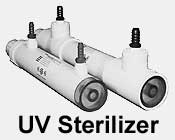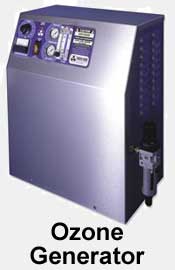Photo Courtesy of Aquatic Ecosystems, Inc.

Anytime fish are cultured, they are crowded and they are stressed. Crowded conditions degrade water quality and increase transmission of pathogens. Stress decreases the immune response, making the fish more susceptible to disease. This is a dangerous combination that can lead to disease and massive fish kills in all culture situations. In recirculation systems, fish are greatly more crowded than in traditional aquaculture and water quality can quickly change for the worse. One way to minimize disease outbreaks is to disinfect the system water. This is commonly attempted using either UV light or ozone.
 |
Ultraviolet light is the shorter wavelength radiation just past violet in the visible range. Shorter wavelengths pack more energy than longer wavelengths. UV radiation is responsible for sunburn, of course, and it is the same type of damage that UV inflicts during sunburn (altering the cell's DNA and other chemicals) that kills microorganisms. UV sterilizers (sterilizer is an overstatement, properly employed these units can reduce the pathogen load, but the water will be far from sterile) sold for aquaculture direct the water flow close to a UV bulb. The effectiveness of the unit depends on the intensity of the bulb, the average distance of the water from the bulb, and the flow rate (which determines the duration of irradiation).
While UV can be an effective disinfectant, there are problems with its use in water. First, the water itself absorbs the radiation and second, particles and colors in the water absorb even more. UV will kill waterborne microbes, but it must reach them first. Water in recirculation systems is usually stained and carries a large amount of smaller particulates, UV sterilization should be applied at a point in the system where water is the cleanest and it works best in systems that have particularly aggressive solids removal coupled with foam fractionation. Further, when selecting a unit it is wise to "oversize" the unit selecting one with a greater stated capacity (expressed as flow rate) than the system actually has. A further caution in this area is that UV bulbs lose power rather quickly and must be replaced at least annually. Even with these drawbacks, the fact is that UV sterilization can be employed much less expensively than ozonation.
 |
Ozone (O3) is triatomic oxygen. Free oxygen usually exists as a diatomic (O2) gas, of course, but if the paired atoms are torn apart by energy (cosmic rays in the upper atmosphere or an electrical arc here in our world), ozone is formed. Ozone is unstable with a half life of about 12 h. It is highly reactive; the third oxygen atom is readily "given away" to many compounds, oxidizing them. This strong oxidizing reaction is what kills microbes and makes ozone damaging to human lungs. Because of this instability, ozone must be generated on site. There are several ways to make ozone, the most commonly employed method in aquaculture is called a corona discharge generator and employs an electric arc to split the diatomic molecule. UV ozone generators are also sold for aquaculture, but they are capable of producing only low levels. Ozone can be made from a feed gas of either air or pure oxygen, in either case, the gas needs to be clean and dry. Generation from air requires more energy because the corona produces less ozone per second of operation. Once the ozone is generated, it must be transferred to the water. While any of the oxygen transfer methods mentioned in the previous chapters can be used, loss of the ozone in off gas is a particular concern, because ozone is expensive and because it is dangerous to humans. It is perhaps best to use a transfer method that does not produce an off gas, like an aeration cone. If off gas is produced, it should be vented outside.
Like UV, ozone must have a minimum contact time with the pathogen to kill it. Typically, ozone must be in contact with the pathogen for a minute or two at an ozone concentration of a few tenths of a mg/L. Practically, this is difficult to achieve in a recirculation system where there are a lot of compounds for the ozone to react with and thus rapidly dissipates. So, like UV, it is not so much a matter of ozone sterilization, but of reducing the pathogen load somewhat. If sufficient ozone residual is maintained to kill pathogens, care must be taken to reduce the concentration before it flows back over the fish. It can be stripped in packed column, which is generally not desirable because of associated oxygen loss and human health concerns. Interestingly, UV at slightly longer wavelengths than are used to generate ozone can break it down. Perhaps, the most practical approach is to ozonate a side stream in the recirculation loop, not the entire flow. This way the concentration is higher for pathogenicide, but it is then diluted as it rejoins the main flow before entering the fish tank.
Besides disinfection, ozone has other positive effects in a recirculation system and improvement in the system's water quality may be as important in improving fish health as actually killing pathogens. For one thing, as ozone breaks down it produces oxygen. It also directly oxidizes nitrite to nitrate so effectively, in fact, that the system's biofilter may lose its nitribacter type bacteria. This is not a problem unless the ozonation is terminated for some reason, at which point the nitrite may spike to dangerous levels! It also generally oxidizes organic compounds, clarifying the water and breaking complex molecules into smaller, more biodegradeable compounds. Ozone can have several beneficial effects for a recirculation system, but it is somewhat complex and expensive to install and operate. For these reasons it is generally only used in large, high intensity operations that also use oxygenation.